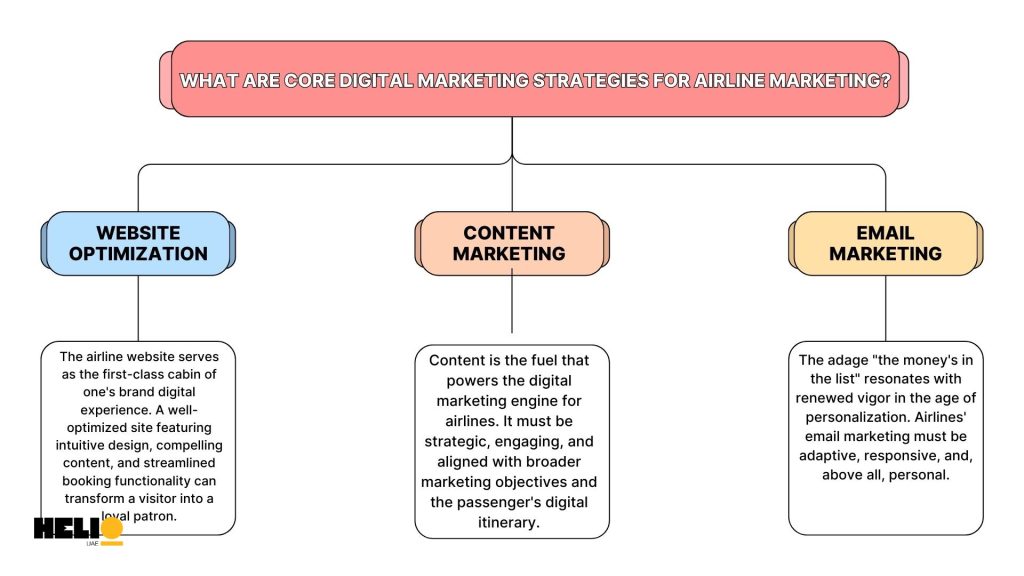Listen to this blog post:
What are the Advantages of Digital Marketing in the Aviation Industry? Today’s airline industry races through a highly competitive atmosphere, where the impact on travelers stretches far beyond the conventional marketing frameworks. Living in a digital age, airlines are required to perfect the intricate balance of art and science in online branding. Overcoming the hurdles of ad saturation, the dense networks of social media, and the fluctuating trends of SEO demands a strategy as cutting-edge and versatile as the newest jets in the sky.
To navigate these digital skies, this guide from Helio Advertising outlines several strategic pillars essential for aviation marketing professionals. These strategies, executed with precision and creativity, will ensure that your airline remains at the forefront of the digital frontier, captivating and intriguing passengers in a crowded market.
What Is Airline Marketing?
Digital marketing success depends heavily on knowing your audience and the market conditions. This market is diverse for airlines and changes with global events and economic changes. Today’s airline customers include business travelers, eco-friendly tourists, and those who love luxury, all wanting a safe and enjoyable flight. Shifts like a sudden increase in holiday travel after vaccination drives can quickly change which customer groups are most important. These changes highlight the need for flexible marketing strategies that adapt rapidly to new conditions.
Keeping Pace with Market Dynamics in Digital Marketing for Airlines
Consumer trends in the airline industry reflect a broader social, economic, and geopolitical context. The inexorable push towards sustainability, the exigencies of the COVID-19 pandemic, and the elusive quest for ‘contactless travel’ are a few instances where the industry has had not only to react but adapt its marketing approach. The key lies in not just keeping pace with these dynamisms but forecasting them. Knowing your market means staying a step ahead of its fickle sentiments.
| Core Strategy | Key Elements | Impact |
|---|---|---|
| Website Optimization | – Intuitive design – Compelling content – Streamlined booking functionality | – Enhances user experience – Converts visitors into loyal patrons – Improves booking rates |
| SEO and CRO | – Tailored content and keywords – Simplified user interfaces – Optimized checkouts | – Increases traffic – Guides users to bookings – Boosts visibility and conversions |
| Content Marketing | – Educational narratives – Blogs, infographics, and videos – Strategic, engaging content | – Fuels engagements and social shares – Aligns with passenger journeys – Enhances brand awareness |
| Email Marketing | – Personalized emails – Segmentation for targeted messaging – Exclusive subscriber offers | – Strengthens customer relationships – Drives repeat business – Improves retention and loyalty |
Advantages of Digital Marketing in the Aviation Industry
Digital marketing offers unparalleled opportunities for the aviation industry to reach and engage its target audience effectively. Here are the key advantages:
- Enhanced Global Reach: Airlines can connect with potential travelers worldwide through social media, SEO, and targeted ads, ensuring their message reaches the right audience at the right time.
- Cost Efficiency: Compared to traditional advertising, digital campaigns offer a higher return on investment by targeting specific demographics and reducing wastage.
- Personalization: Advanced analytics and CRM tools allow airlines to create tailored experiences, from personalized email offers to dynamic retargeting ads that cater to individual preferences.
- Real-Time Engagement: Platforms like Twitter enable airlines to address customer concerns, provide updates, and manage brand reputation instantly, fostering trust and loyalty.
- Data-Driven Decisions: By leveraging analytics, airlines can track customer behavior, optimize campaigns, and predict trends, ensuring their strategies align with market demands.
- Sustainability Marketing: Digital platforms provide an ideal medium for promoting eco-friendly initiatives, resonating with today’s environmentally conscious travelers.
This integration of technology and creativity ensures airlines remain competitive, adaptable, and customer-focused in an ever-changing industry. With these advantages in mind, implementing core strategies can help airlines fully leverage the potential of digital marketing. digital marketing cost in dubai for airlines varies based on compaign scale, target audience, and the digital marketing channels for promotons.
What Are Core Digital Marketing Strategies for Airline Marketing
In this digital airspace, airlines must have a wide wingspan to cover the essentials and be flexible enough to explore the horizons. Core digital marketing strategies act as the ailerons and flaps, allowing for controlled ascent and descent through the marketing funnel.
1. Website Optimization Is Important In Digital Marketing for Airlines
The airline website serves as the first-class cabin of one’s brand digital experience. A well-optimized site featuring intuitive design, compelling content, and streamlined booking functionality can transform a visitor into a loyal patron.
Reinforce Your Presence in the Cloud
SEO for airlines is not just about being at the top of search results—it’s about being found at the right moment. This means understanding the customer’s online behavior patterns and tailoring content and keywords to captivate.
Increased Traffic Is the New Takeoff
Conversion rate optimization (CRO) techniques are runway lights guiding potential customers to take flight and book. From simplified user interfaces to streamlined checkouts, each click should be a step closer to boarding.
2. Content Marketing, the Fuel of Digital Marketing in Aviation
Content is the fuel that powers the digital marketing engine for airlines. It must be strategic, engaging, and aligned with broader marketing objectives and the passenger’s digital itinerary.
Educational Journey Mapping
Understanding the places customers visit—both physically and digitally—en route to a decision can help craft an educational narrative, from pre-flight anticipation to in-flight entertainment and post-flight reflection.
Creativity at Cruising Altitude
Blog posts on exotic destinations, infographics on onboard services, and videos capturing the transcendence of flying all have their place in the content marketing mix, fueling engagements and social shares.
3. Don’t Forget Email Marketing Effect In Digital Marketing for Airlines
The adage “the money’s in the list” resonates with renewed vigor in the age of personalization. Airlines’ email marketing must be adaptive, responsive, and, above all, personal.
Landing in the Inbox with Precision
Strategies for growing a quality email list involve:
- Clean and clear opt-in prompts.
- Incentivized sign-ups.
- The promise of exclusive, subscriber-only offers.
Customizing the In-flight Experience
Segmentation allows for tailoring email content to the unique needs and behaviors of travelers, from the jet-setter with a taste for luxury to the value-conscious passenger on a budget.

Leverage Social Media In Online Marketing for Aviation
Airlines that effectively take to social media are like those glider planes that not only ride the thermals but actively seek out the updrafts—constantly lifting to higher altitudes.
Know Your Social Stratosphere in Digital Marketing for Airlines
Each social media platform is like a different airstrip, catering to a diverse clientele and serving distinct marketing agendas.
1. Facebook and the Art of Storytelling
With its vast user base and sophisticated advertising options, Facebook is an essential platform for sharing the brand’s narrative and engaging audiences through compelling stories.
2. Instagram’s Panoramic Vistas
A platform built on visuals, Instagram allows airlines to showcase breathtaking photography and videos, offering a window seat to the world for followers and inspiring their travel aspirations.
3. Twitter and Real-Time Communication
An airline’s Twitter presence should be akin to air traffic control, providing real-time updates, answering queries, and engaging with customers swiftly and decisively.
4. LinkedIn, the Business Class
For B2B connections, thought leadership content, and professional networking, LinkedIn is the first-class lounge of social media for airlines.
Navigating the Social Media Storm
Professional networking and user-generated content campaigns provide additional thrust and lift, while proactive community management helps chart a smooth course through customer interactions and potential crises.

Advanced Strategies of Digital Marketing for Airlines
For airlines to reach their point of destination quickly and efficiently, advanced digital marketing techniques serve as powerful engines and sophisticated avionics that keep the craft on course.
1. Harnessing the Power of Search Engine Marketing
Paid search, often the afterburners of SEM, can provide the temporary thrust airlines need during key marketing campaigns or to reach high-priority audiences.
Turbulence Avoidance with Data
Using robust analytics tools, airlines can track, analyze, and optimize their SEM efforts, avoiding marketing storm cells that can waste budget and energy.
2. Programmatic Advertising: The Auto-Pilot for Ad Campaigns
Programmatic advertising automates the buying and selling of digital media through real-time bidding—allowing airlines to precisely target ads to the right people at the right time.
Precise Instrumentation for Programmatic Success
Data management platforms turn the plethora of customer data from various sources into actionable insights, steering programmatic campaigns toward conversion.
3. Mobile Marketing: Staying in the Airflow
In an ecosystem where tablets and smartphones are the window panes to the world, mobile marketing is not an option—it’s a mission requirement.
Mobile Apps as Loyalty Engines
A well-designed mobile app brings frequent flyers back for more, offering convenience, speed, and a direct channel to the brand.
Analyzing and Optimizing Campaigns of Digital Marketing in the Airline Industry
Data is the altimeter of digital marketing—tapping into it, deciphering it, and using it to course-correct is imperative for airlines looking to optimize their online strategies.
1. Flight Data Recorder of Marketing Campaigns
From website analytics to social media performance, a comprehensive approach to data collection is akin to a black box that can reconstruct and improve any digital marketing campaign.
2. KPIs: The Beacon in the Night
Know which lights to follow and when to adjust with KPIs fine-tuned to the airline’s specific goals—whether that’s booking conversions, email open rates, or social media engagement.
3. Human-Machine Collaboration for Success
While machines handle the heavy lifting of data analysis, it’s the digital marketing team that brings the human touch—the empathy and understanding that could only be conferred upon passengers by a fellow traveler.
Future Trends in Airline Digital Marketing
The sky is not the limit—especially when it comes to pushing the boundaries of marketing in the airline industry. Emerging trends and technologies are set to redefine and expand the realms of possibility.
1. Technology on the Horizon
Artificial intelligence will soon be co-piloting marketing campaigns, VR and AR will provide passengers a sneak peek into the window seats before they book, and blockchain could revolutionize loyalty programs.
2. Steering through the Regulatory Airspace
With significant technological power comes great responsibility— personal data privacy and adherence to emerging regulations such as GDPR or CCPA.
3. Marketing to Sustainable Horizons
Sustainability is a nonstop flight to the future, and airlines adopting eco-friendly practices will find an increasingly warm reception from environmentally conscious travelers.
Conclusion
The digital age has ushered in a new era for airline marketing. An era where, with the right strategies, the right tools, and the agility to adapt, the skies are limitless. It’s not just about flying higher; it’s about doing so with purpose, precision, and passion—inviting passengers to join in the journey and the brand’s continuous evolution. Staying competitive in the aviation industry means never forgetting that for all the algorithms and analytics, the heart of marketing is human.
In the fast and fluid world of airline digital marketing, the route to success is often more about your team on the ground than the altitude you reach. Partner with Helio, experts in crafting digital campaigns with the precision and power of a fighter jet. Our team can help you identify and implement strategies to maximize your online presence and propel your brand to the next level. Welcome aboard—your digital transformation starts here.





